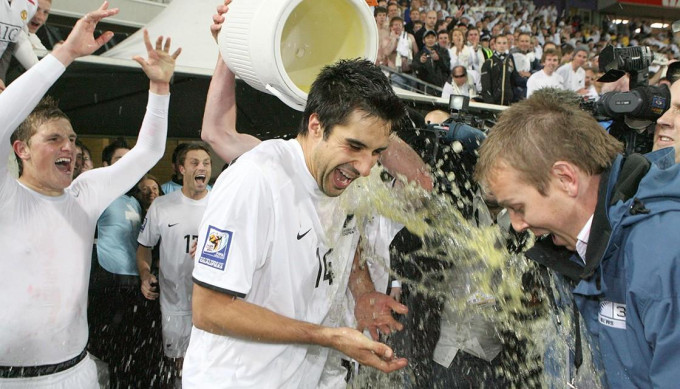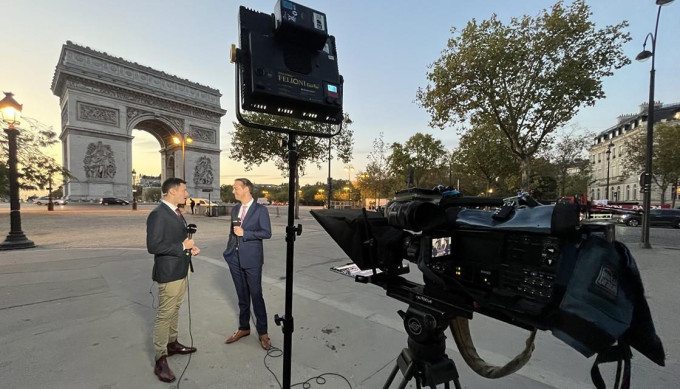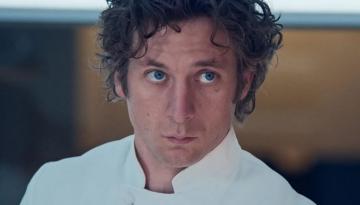Newshub closure: Andrew Gourdie remembers the day he realised what it meant to be part of the 3 News team

Opinion: September 8, 2006. It was a Friday evening. The bulletin was pretty well sorted.
At this point in the week, the staff on level two at our Flower Street office were only interested in how many beers and what variety of wines would emerge from the office of our news boss, Mark Jennings.
The iconic drinks trolley would rattle with the clinking of bottles to alert the newsroom that drinks were up. Like mice in a plague, staff would run from all corners of the building - an old cheese factory in Auckland's Eden Terrace - to grab what was on offer.
On this night, the beers would have to wait.
At 5:30pm, news filtered through that Australian motorsport legend Peter Brock had died after crashing into a tree while driving in a rally outside of Perth in Western Australia.
Brocky was an icon on both sides of the Tasman. This was big.
Clint Brown was our sport presenter at the time. Browny had a strong association with motorsport and he knew Peter well. He made it clear we needed to throw out the bulletin and lead with this.
The time pressure we were under to make this happen was immense.
Back in those days, newsrooms were very competitive places. Reporters would do anything to be on the big story. The talent was limitless, the personalities were big, and the egos were bigger.
At that moment, there were no egos.
Everyone in the team instinctively knew their roles and got to work.
Clint was a larger than life character who, on a daily basis, would loudly imitate rally car noises "PPPPPRRRRRRRRPPPPPPP!!!!!!!" as he entered the office wearing his Subaru polo shirt and New Balance trainers.
He instantly became hyper-focused.
A modern-day Wikipedia page came to life as Browny instantly recalled all of the big moments that punctuated Brock's career off the top of his head. Along with another of the sport department's great motorsport minds, Shaun Summerfield, the pair bounced ideas between them and quickly identified the must-have moments we would need to tell the story of a remarkable life and career.
Producer Curt Jones re-organised the bulletin - changing promos and headlines up until the last second. Clint crafted the script. Shaun knew all of the key dates and began searching the archive.
The words came easy to Clint, but quickly accessing all of Brock's career highlights was not. Along with the Sports Tonight team, Sam Ackerman and I hit the new library and sourced the tapes we would need, with help from the newsroom librarians.
I had never experienced anything like it. Everyone worked quickly, calmly and methodically.
The printers spewed endless streams of printouts from the ENPS news system which detailed the tape numbers and timecodes of the vision we would need to tell this important story.
The Betacam SP tapes we used were as heavy as bricks and as big as the bible. We carried stacks of them from the library, piled up to our noses, ensuring all of them were cued to the correct points to save time in the edit booth.
In the space of 15 minutes, Clint had written a script that in any other circumstances might have taken an entire day to compose in order to adequately pay tribute to such a figure.
Shaun sat in with the fastest editor on shift to oversee the compiling of the story. They had around 20 minutes. They somehow pulled together three minutes of expertly crafted television, complete with pictures that had just arrived from across the Tasman showing the wreckage of the car in which Brock met his fate.

It's a minor miracle anything made it to air that night, let alone the polished item that led the bulletin.
After a frantic and focused hour, we all stood around the television and watched Clint read the intro to a story that perfectly encapsulated the tragedy that unfolded in Perth, and paid fitting tribute to a sporting icon.
We watched what our competitors put to air on 1 News. We were proud of our work.
There was a great sense of responsibility and a duty of care within the newsroom to get stories like this right. There was a feeling of satisfaction in knowing we did this one justice.
Then, the beer was a little warm, but it tasted good.
That was the day I realised what it meant to be part of the 3 News team.
That hour had a profound impact on all of us who were part of the effort to get that story to air. It was a moment of intuitive teamwork that shaped countless examples like it in the years that followed - a collective way of working when it came to telling stories that really mattered.
Viewing habits and expectations have changed a lot since that day. Broadcasting technology has too.

What hasn't changed is the commitment of the people in the Newshub team.
It's an attitude that is woven deep into the fabric of a culture of a team that has always known when it needs to drop everything and pull together, working alongside camera operators, editors, librarians, producers and control room staff to deliver important stories for our audiences.
All of the senior reporters and presenters you've seen on your screens have at one time or another been the ones to selflessly gather the vision, sit in on an edit, and put in the work for someone else. They do it because it's in the best interests of the team and the product that goes to air every night.
Thank you for watching.
Opinion: September 8, 2006. It was a Friday evening. The bulletin was pretty well sorted.
At this point in the week, the staff on level two at our Flower Street office were only interested in how many beers and what variety of wines would emerge from the office of our news boss, Mark Jennings.
The iconic drinks trolley would rattle with the clinking of bottles to alert the newsroom that drinks were up. Like mice in a plague, staff would run from all corners of the building - an old cheese factory in Auckland's Eden Terrace - to grab what was on offer.
On this night, the beers would have to wait.
At 5:30pm, news filtered through that Australian motorsport legend Peter Brock had died after crashing into a tree while driving in a rally outside of Perth in Western Australia.
Brocky was an icon on both sides of the Tasman. This was big.
Clint Brown was our sport presenter at the time. Browny had a strong association with motorsport and he knew Peter well. He made it clear we needed to throw out the bulletin and lead with this.
The time pressure we were under to make this happen was immense.
Back in those days, newsrooms were very competitive places. Reporters would do anything to be on the big story. The talent was limitless, the personalities were big, and the egos were bigger.
At that moment, there were no egos.
Everyone in the team instinctively knew their roles and got to work.
Clint was a larger than life character who, on a daily basis, would loudly imitate rally car noises "PPPPPRRRRRRRRPPPPPPP!!!!!!!" as he entered the office wearing his Subaru polo shirt and New Balance trainers.
He instantly became hyper-focused.
A modern-day Wikipedia page came to life as Browny instantly recalled all of the big moments that punctuated Brock's career off the top of his head. Along with another of the sport department's great motorsport minds, Shaun Summerfield, the pair bounced ideas between them and quickly identified the must-have moments we would need to tell the story of a remarkable life and career.
Producer Curt Jones re-organised the bulletin - changing promos and headlines up until the last second. Clint crafted the script. Shaun knew all of the key dates and began searching the archive.
The words came easy to Clint, but quickly accessing all of Brock's career highlights was not. Along with the Sports Tonight team, Sam Ackerman and I hit the new library and sourced the tapes we would need, with help from the newsroom librarians.
I had never experienced anything like it. Everyone worked quickly, calmly and methodically.
The printers spewed endless streams of printouts from the ENPS news system which detailed the tape numbers and timecodes of the vision we would need to tell this important story.
The Betacam SP tapes we used were as heavy as bricks and as big as the bible. We carried stacks of them from the library, piled up to our noses, ensuring all of them were cued to the correct points to save time in the edit booth.
In the space of 15 minutes, Clint had written a script that in any other circumstances might have taken an entire day to compose in order to adequately pay tribute to such a figure.
Shaun sat in with the fastest editor on shift to oversee the compiling of the story. They had around 20 minutes. They somehow pulled together three minutes of expertly crafted television, complete with pictures that had just arrived from across the Tasman showing the wreckage of the car in which Brock met his fate.
It's a minor miracle anything made it to air that night, let alone the polished item that led the bulletin.
After a frantic and focused hour, we all stood around the television and watched Clint read the intro to a story that perfectly encapsulated the tragedy that unfolded in Perth, and paid fitting tribute to a sporting icon.
We watched what our competitors put to air on 1 News. We were proud of our work.
There was a great sense of responsibility and a duty of care within the newsroom to get stories like this right. There was a feeling of satisfaction in knowing we did this one justice.
Then, the beer was a little warm, but it tasted good.
That was the day I realised what it meant to be part of the 3 News team.
That hour had a profound impact on all of us who were part of the effort to get that story to air. It was a moment of intuitive teamwork that shaped countless examples like it in the years that followed - a collective way of working when it came to telling stories that really mattered.
Viewing habits and expectations have changed a lot since that day. Broadcasting technology has too.
What hasn't changed is the commitment of the people in the Newshub team.
It's an attitude that is woven deep into the fabric of a culture of a team that has always known when it needs to drop everything and pull together, working alongside camera operators, editors, librarians, producers and control room staff to deliver important stories for our audiences.
All of the senior reporters and presenters you've seen on your screens have at one time or another been the ones to selflessly gather the vision, sit in on an edit, and put in the work for someone else. They do it because it's in the best interests of the team and the product that goes to air every night.
Thank you for watching.
Disclaimer: The copyright of this article belongs to the original author. Reposting this article is solely for the purpose of information dissemination and does not constitute any investment advice. If there is any infringement, please contact us immediately. We will make corrections or deletions as necessary. Thank you.





